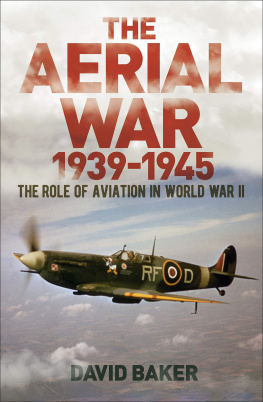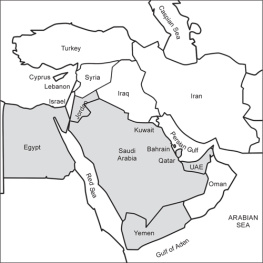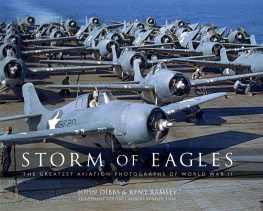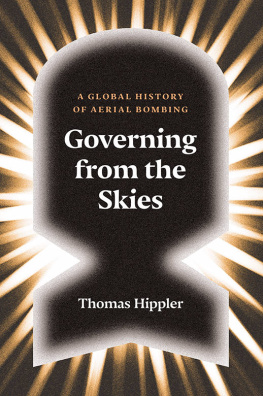TO SARAH, GUY, AND TOBY AND TO DEE, THE MOST PATIENT EDITOR I KNOW
WORLD WAR II FROM ABOVE
By Jeremy Harwood
First published in North America in 2014 by Zenith Press, an imprint of Quarto Publishing Group USA Inc., 400 First Avenue North, Suite 400, Minneapolis, MN 55401 USA, by arrangement with Quid Publishing.
2014 Quid Publishing
All rights reserved. With the exception of quoting brief passages for the purposes of review, no part of this publication may be reproduced without prior written permission from the Publisher.
The information in this book is true and complete to the best of our knowledge. All recommendations are made without any guarantee on the part of the author or Publisher, who also disclaims any liability incurred in connection with the use of this data or specific details.
We recognize, further, that some words, model names, and designations mentioned herein are the property of the trademark holder. We use them for identification purposes only. This is not an official publication.
Zenith Press titles are also available at discounts in bulk quantity for industrial or sales-promotional use. For details write to Special Sales Manager at Quarto Publishing Group USA Inc., 400 First Avenue North, Suite 400, Minneapolis, MN 55401 USA.
To find out more about our books, visit us online at www.zenithpress.com.
Digital edition: 978-1-6278-8236-1
Hardcover edition: 978-0-7603-4573-3
Conceived, designed, and produced by
Quid Publishing
Level 4 Sheridan House
Hove BN3 1DD
England
Design and illustration: Simon Daley
Cover image:
Boeing B-17F formation over Schweinfurt, Germany, on Aug. 17, 1943.
Reprinted by permission from Air Force Magazine, published by the Air Force Association.
WORLD WAR II
FROM ABOVE
AN AERIAL VIEW OF THE GLOBAL CONFLICT
JEREMY HARWOOD

A squadron of B-17 Flying Fortresses from the US 8th Army Air Force is captured in the air over Germany on its way to bomb Stuttgarts ball-bearing factories on September 7, 1943. The American high command was wedded to daylight precision bombing, believing that their heavily-armed bombers could fight off Luftwaffe fighter attacks on their own. They were to be proved wrong. Only the eventual arrival of long-range fighter escorts managed to reverse the ever-mounting rate of losses.
CONTENTS
INTRODUCTION
Looking at it from a 21st-century perspective, the vital role air power plays on the modern battleground seems self-evident. Looking back into the past, however, it may well seem surprising that it took a relatively long time for this to be fully recognized. As Tami Biddle, a noted historian of air power has written, virtually every manifestation of 20th-century air power, was envisaged and worked out in at least rudimentary form between 19141918that is, during World War I.
This is why this book, though primarily concerned with World War II, takes the war to end war as its starting point. To quote from Biddle again: Those who wish to understand the role of aircraft in subsequent conflicts do well to turn back to the experience of the Great War precisely because all the roots of modern practice are there to be explored.
It was as a reconnaissance instrument that the airplane first made its mark. Indeed, the outcomes of the battles of the Marne and Tannenberg at the start of the war might have been very different if first the Allies and then the Germans had not taken advantage of the intelligence provided by the airborne scouts. Aircraft soon became invaluable for artillery spotting; aerial photography also proved vital in building up a comprehensive picture of what was going on in the trenches and behind the lines on the other side of the hill. The need to achieve dominance in the air led to the birth of the fighter; the development of tactical and long-range strategic bombers was not far behind. By 1918, air power was on the verge of coming of age.
It was not surprising therefore that, in the period between the two world wars, fears about the extraordinary destructive powers of aircraft flourished. The bomber, people were grimly assured, will always get through. Apostles of air power, such as the Italian air strategist Giulio Douhet and the American aviator Billy Mitchell, fuelled such fears. In the 1930s, Goering boasted that his newly created Luftwaffe, then the worlds most powerful air force, stood ready to carry out every command of the Fuehrer with lightning speed and undreamed-of might.
The truth was somewhat different. Though air power indeed emerged as a major strategic element during World War II, it could not win wars on its own. What the war showed was that, operating in close collaboration with the other armed forces, it was the vital ingredient in the cocktail that won battlefield victories. On both the Western and Eastern Fronts, air power complemented ground power in bringing about the defeat of Nazi Germany. In the Far East, its collaboration with surface forces was instrumental in achieving the collapse of imperial Japan.
The actual air war, of course, is a fascinating story in itself. Highlights of this book include vivid accounts of the great strategic bombing offensives, from the Luftwaffes attempt to blitz Britain into submission to the RAFs great area bombing raids that laid waste to Germanys major cities, and the USAAFs precision strikes on key German targets, to the 1945 fire raids on Japan and the atomic bombing of Hiroshima and Nagasaki, which brought the curtain down on the war. The book also places equal emphasis on another important side of the story, which is less familiar than it ought to be. This is the unsung efforts of the spies in the skies to obtain accurate air intelligencea struggle that began even before the outbreak of hostilities.
Arguably, the work of the aerial photographers and photographic interpreters had even more impact on the outcome of the war than that of the Bletchley Park code-breakers. Indeed, some commentators believe that, without it, the Allies might well have lost the war. The detection of Hitlers vaunted vengeance weapons is a prime case in point. Had they remained undetected and gone into operation as the Germans had planned, it is an open question as to whether they would have delayed Allied victory in Normandy at the best, or, at the worst, brought about a humiliating Allied defeat.
A US photographer managed to shoot this dramatic picture of bombs falling on the industrial city of Terni, Italy, in late 1943. The bombers involved in the raid came from the US 12th Army Air Force, their targets being the citys steel works and railway marshalling yards. Milan, Foggia, Naples, Palermo, Treviso, and Turin were among other Italian targets that were heavily bombed. Rome was largely spared after Pope Pius XI appealed to President Roosevelt not to attack the capital.
AXIS EXPANSION
By 1942, Hitlers 1,000-Year Reich had reached its greatest territorial extent. Nazi forces occupied practically the whole of mainland Western Europe, had penetrated deep into Russia, and, in North Africa, had reached El Alamein.
















